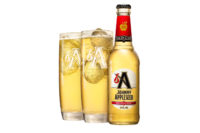New products in hard cider category push market growth

The global market for apple and fruit-flavored cider is expected to see a CAGR of more than 6% from 2017-2021, driven by the launch of new products by various market players and growing demand for premium cider products.
Technavio (technavio.com) market research analysts forecast the global cider market to grow at a CAGR of more than 6% during the forecast period, according to their latest report.
The market study covers the present scenario and growth prospects of the global cider market for 2017-2021. The report also lists apple-flavored cider and other fruit flavored ciders as the two major product segments of which, apple flavored cider accounted for over 88% of the market share in 2016.
According to Manjunath Reddy, a lead analyst at Technavio for non-alcoholic beverages research, “The trend of premiumization is another factor that will help the market grow during the forecast period. With the turnaround of the global economy, there is an increase in the disposable income of consumers, which has led to increased demand for premium products.
Technavio food and beverage analysts highlight the following three market drivers that are contributing to the growth of the global cider market:
- New product launches
- Growing demand for premium cider products
- Increase in investments
- New product launches
One of the main growth drivers of the global cider market is the launch of new products by various players in the market. The new products help to keep alive the interest of the consumers and help the players in the market maintain a competitive edge over their rivals. For instance, in June 2016, Smirnoff launched its two new ciders in flavors such as raspberry & pomegranate; and passionfruit and lime, with both the products mixed with Smirnoff vodka. The products were sold in a clear glass bottle to let the colors of the drinks show through. Similarly, in April 2016, Pimm's introduced three new flavors: summer fruits, mango and passionfruit, and plum and red apple.
Growing demand for premium cider products
The presence of popular brands like Kopparberg, Woodchuck and Angry Orchard has increased the demand for premium-quality cider. Premium brands exhibit higher demand as compared to economically priced products due to a rise in disposable income, consumption of alcohol as a status symbol, and the association of better quality and taste with premium labels. Premium cider accounts for 34.5% of all cider volumes.
“Even in mature markets like the U.S. and France, premiumization is driving the market with consumers shifting from local spirits to premium spirits. Hence, the trend for premiumization across all product categories will boost the growth of the cider market during the forecast period,” says Manjunath.
Increase in investments
The cider market is a niche market, but it is growing rapidly. The demand for cider is increasing in countries such as the U.S. where consumers are opting for cider consumption instead of beer. The players in the market are investing in increasing the production of cider to meet the growing demand. For instance, in 2014, Heineken invested about USD 157 million in its Manchester brewery and Hereford cider plant to increase the production in both the facilities. The company plans to increase the production capability of its Hereford cider plant from 4 million hectoliters to 65 million hectoliters. In March 2016, Aston Manor Cider announced that it is planning to invest about U.S. $4 million in its major production facilities. The company is using the investment to increase the capacity and capability and improve loading and shipping facilities at its Devon production facility.
Looking for a reprint of this article?
From high-res PDFs to custom plaques, order your copy today!








